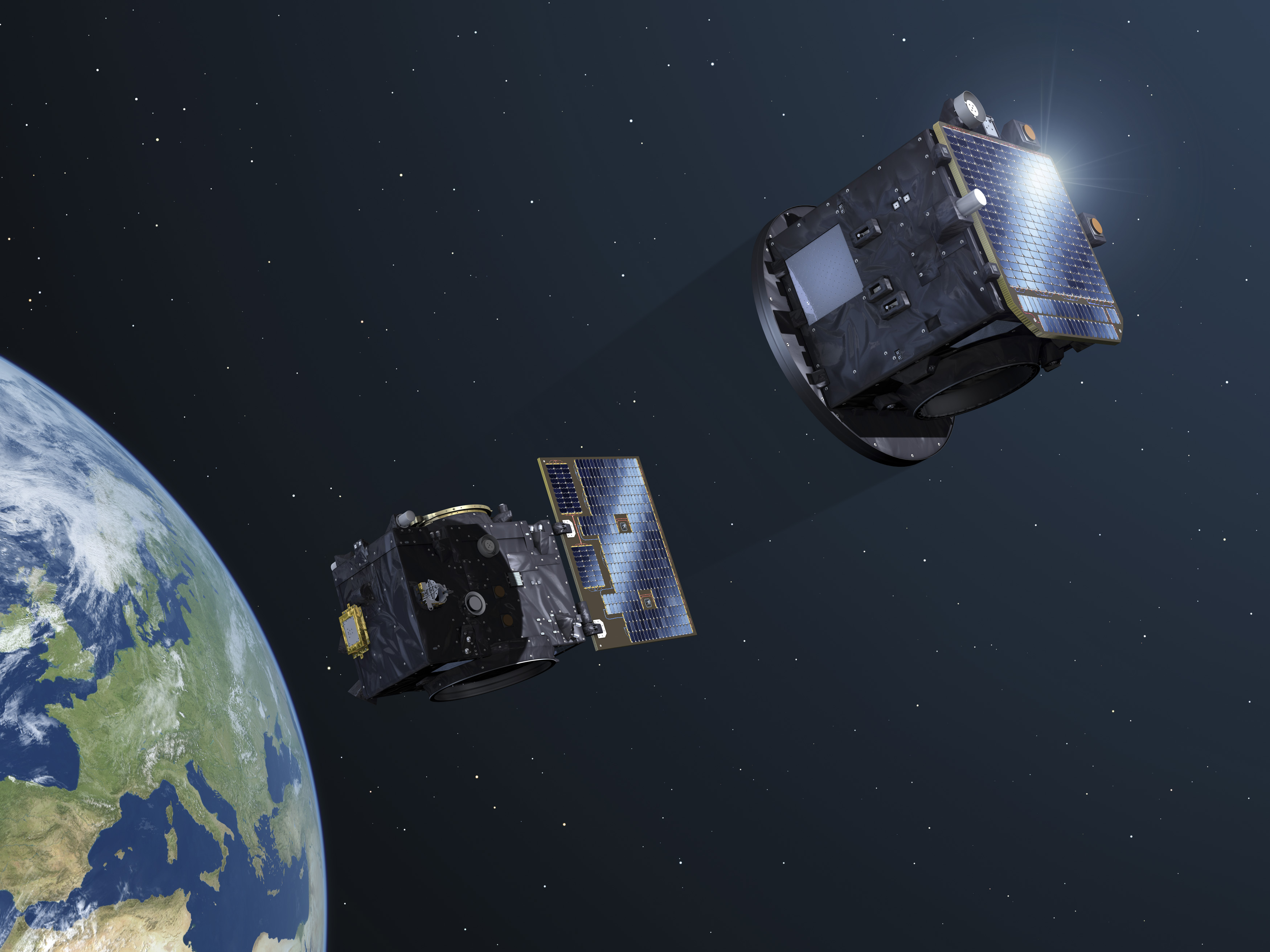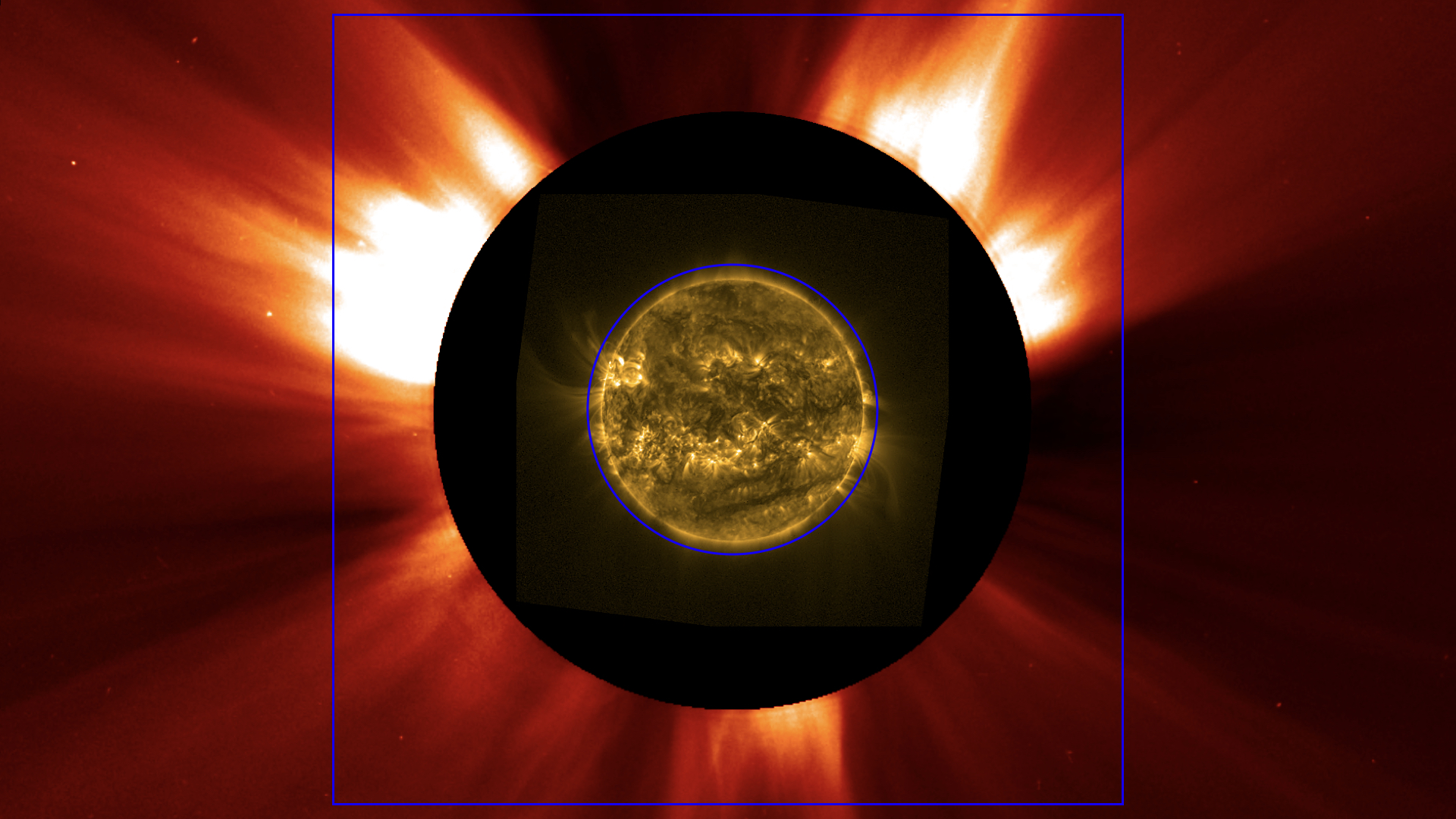ASPIICS onboard Proba-3 - Belgian research in the shadow of a satellite
Proba-3 is the latest ESA mission to be launched in December, 2024. Proba-3 consists of not one, but two satellites that will fly in precise formation around the Earth. One satellite will cast a shadow onto the other during 6 hours of the orbit, allowing the latter to observe a solar eclipse. During a solar eclipse, the solar atmosphere, or corona, becomes visible. The exploitation of ASPIICS, the instrument imaging the solar corona, is in the hands of the Royal Observatory of Belgium (ROB), where the associated scientific research will also be coordinated.
An artificial solar eclipse
One of the satellites carries a disk to obscure the sun, just as the moon does during a natural solar eclipse. The second satellite carries the instrument ASPIICS, the Association of Spacecraft for Polarimetric and Imaging Investigation of the Corona of the Sun, which takes advantage of these artificial solar eclipses to produce images of the solar corona.

Credit: ESA - P. Carril
Filling in the blind spot
Andrei Zhukov (ROB), principal investigator of ASPIICS: “In visible light, we can observe quite well further away from the solar surface. In extreme ultraviolet light, we can clearly see the corona close to the solar rim. The area in between is not visible. This is a blind spot.”
During a natural total solar eclipse, the moon covers the sun perfectly. For observers on Earth who are in the moon's shadow, this area becomes visible. However, a natural solar eclipse is rare, lasts only a few minutes and is only visible when there are no clouds in front of the sun blocking the view. Sometimes an eclipse can also only be observed from an inaccessible area on Earth.

ASPIICS will image the area between the blue square and the blue circle, which is between 1.099 and 3.0 solar radii.
The red image was taken in visible light by LASCO/C2 onboard the satellite SOHO. The yellow image is taken in extreme ultraviolet light by the SWAP telescope onboard Proba-2.
Andrei continues, “Proba-3 is intended to mimic a total solar eclipse for more than just a few minutes. This is achieved when the small satellite, as seen from the second satellite, covers the solar disk completely for an extended period.
At a distance of 144 meters, the disk's shadow is 7.5 centimeters wide. The eye of the telescope on the second satellite is 5 centimeters wide and must remain completely in the shadow of the occulting disk to observe a total eclipse. To achieve this, both satellites will fly in formation with millimeter precision. This is a huge technological challenge.”
Orbit around Earth
Proba-3 will be launched in an elliptical orbit around Earth. Only when Proba-3 is in the farthest part of the ellipse, which is apogee, will the satellites fly in formation. At that stage of their orbit, they are easier to position because of their lower speed. Formation flying is achieved with thrusters which require fuel. Obviously, the amount of fuel that can be carried on a satellite is limited, so trade-offs have to be made. Proba-3 completes a full orbit in 20 hours. The compromise is that the satellites will fly in formation during 6 hours of an orbit, several times a week. The amount of fuel is thus calculated for a mission with a duration of 2 years.
Andrei Zhukov: “We carry fuel for about 1000 hours of formation flying and will observe the low solar corona with ASPIICS during 2 orbits per week, 6 hours uninterrupted each time. This is 100 times longer than a total solar eclipse of only a few minutes as we observe them from Earth.”
Attention to detail
One image of ASPIICS is actually composed of three separate observations. The part of the solar atmosphere closer to the sun is photographed with a shorter exposure time than the less bright regions further away. In this way, each part of the solar atmosphere can be imaged clearly and with the best contrast.
Researchers suspect that the answers to important scientific questions lie in the details of the images. They want to know where and how the solar wind originates and accelerates, how solar plasma dislodges and eventually races through space as a plasma cloud. They also hope to better understand the physical processes that heat the solar atmosphere to millions of degrees, when the temperature of the sun's surface is only a few thousand degrees.
From idea to launch
The idea for the Proba-3 mission originated 20 years ago: everything began with initial studies by the French space industry and a first proposal for the instrument in 2009. In 2014, the project gained momentum when Andrei Zhukov of the Royal Observatory of Belgium (ROB) was appointed as the new principal investigator and the Centre Spatiale de Liège (CSL) was allowed to build the instrument. A team of scientists, engineers and software specialists was also assembled at the ROB. These experts determine how and when ASPIICS should observe, process the observations and prepare them for scientific use. The software used for this, is very specific and thus custom written for ASPIICS. This work has been ongoing for years. The team is now ready to undertake the instrument's testing after launch and move to the operational phase after 4 months. The first images of ASPIICS should then show that the experiment has succeeded.
A scientist’s playground
Andrei Zhukov: “When I first heard about this project, I was immediately excited. I was able to cooperate with specialists from all over the world, with renowned scientists who had already earned their stripes in past space missions, with brilliant engineers, and with talented software developers. Together we are trying to improve current observation techniques. We also expect that the 6-hour observations of solar eclipses will provide unique data. The best is yet to come!”
Teamwork make the dream work
In Belgium, ASPIICS was built by:
- A consortium led by the Centre Spatial de Liege (CSL), made up of 15 companies and institutes from five ESA Member States.
- OIP Sensor Systems (Oudenaarde), as a subcontractor to CSL was responsible for the design and development of the ASPIICS Focal Plane Assembly (FPA) and Camera Electronic Box (CEB).
- Andrei Zhukov (Royal Observatory of Belgium) is the Principal Investigator of ASPIICS and leads the international ASPIICS Science Team that supported the development.
Funding from the Belgian Federal Science Policy Office (BELSPO) through the PRODEX and GSTP programs of the European Space Agency (ESA) was essential.
Other scientific instruments on Proba-3 and Belgian involvement therein:
- DARA, a radiometer, is led by the Swiss institute PMOD. Andrei Zhukov and Marie Dominique (Royal Observatory of Belgium) are part of the research team.
- 3DEES investigates energetic particles. UCL provides the principal investigator. The Royal Belgian Institute for Space Aeronomy and Redwire Space are part of the 3DEES consortium
Spacecraft and ground segment
- The industrial development of the spacecraft and the ground segment is led by the Spanish SENER Aerospace which coordinates the work of a core team consisting of Airbus Defence and Space, Redwire Space (Kruibeke), GMV and Spacebel (Hoeilaart and Liege)
- Amos (Liege) contributed to the 'Fine Lateral and Longitudinal Sensor (FLLS)', as subcontractor of MICOS, Switzerland.
- CSL (Liege) developed the Coarse Lateral Sensor (CLS), supported by Deltatec (Liege) for its Optical Head Unite (OHU).
- Makite contributed to the PROBA-3 satellite validation, in particular the GNSS sensor
- Antwerp Space contributed the space radio frequency baseband equipment
Operations and Exploitation
- Mission operations will be conducted from ESEC (Redu Belgium) in the SmallSat Operations Centre
- Science operations will be conducted from the Proba-3 Science Operations Center at the Royal Observatory of Belgium.





